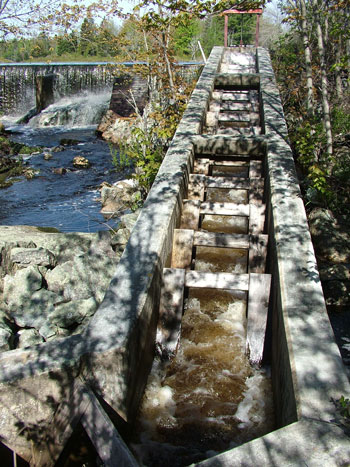Alewife Restoration Easier and
More Difficult

Fish ladder in Hancock County. At left, dam to pond beyond.
One of the discussions at the Maine Alewife Harvesters Association meeting at the Fishermen’s Forum in March focused on alewife restoration.
Alewife restoration, where it has been done with an organized group-funded effort, has been successful in Maine. The results are immediate and increases of returning alewives exponential.
Restoration results are better for alewives than Atlantic salmon. Attempts to restore Atlantic salmon have been going on since the late 1800s. According to Nate Gray, a marine biologist with the Maine Department of Marine Resources, one reason this may be so is the vast numbers of eggs carried by the female alewife. A mature female alewife typically carries 60,000 to 200,000-plus eggs. A lot more than the typical female Atlantic salmon, which averages 7,500. Of the 7,500 salmon eggs, the number that survive to fry is 9-20%. And there are other developmental stages like par and smolt that have to survive.
Where and how the two fish spawn influence survival rates. “Salmon are river and tributary spawners. Alewives spawn in ponds,” wrote Gray. “Salmon have to dig a nest in gravel. Alewifes don’t do that. The alewife spawns in open water and the eggs are on their own for a while before they hatch [3-6 days]. Salmon eggs buried in the gravel in the fall – October, November – don’t hatch out for several months.” During this period, the eggs are susceptible to all manner of maladies, like fungus, predation, and more.
If salmon make it to the smolt stage and swim to the open ocean, their genetic map influences them to swim up between Labrador and Greenland, according to Gray. Scientists have investigated what then happens to them, but their disappearance remains a mystery.
“Salmon recovery methods have remained static for decades,” said Gray. The thinking about salmon recovery has begun to change, with increasing recognition that salmon are key to Maine’s marine and fresh water ecosystems. “We’re still in our infancy scientifically speaking when it comes to restoration. We are getting better at it. But are we getting better fast enough to stem the tide of decline?” said Gray.

Nate Gray, DMR. Alewives are easier to restore, whereas salmon are an easy sell. Fishermen’s Voice photo
Alewives are easier to restore, but it’s more difficult to increase awareness of their plight in the public eye, whereas salmon are an easy sell, said Gray.
“Provide access and egress from appropriate [historical] spawning habitat and you’ve got yourself an alewife run,” said Gray. Alewives are a keystone that many birds and river organisms feast on. But proposals to protect alewife habitat and their runs are sometimes trumped by development and recreational interests, he said.
The Kennebec and Penobscot river watersheds have enormous capacity for alewife reproduction, he said.
Gray said the importance of the alewife goes beyond its role as prey for other species. Citing a 1943 study for the U.S. Department of the Interior Fish and Wildlife Service — “Restoration and Management of the New England Alewife Fisheries With Special Reference To Maine” (Fishery Leaflet 42) by George Rounsfel and Louis Stringer ![]() — Gray noted the longstanding importance of alewives to human food security.
— Gray noted the longstanding importance of alewives to human food security.
